| Listing 1 - 9 of 9 |
Sort by
|
Book
Year: 1970 Publisher: Berlin : Springer,
Abstract | Keywords | Export | Availability | Bookmark
 Loading...
Loading...Choose an application
- Reference Manager
- EndNote
- RefWorks (Direct export to RefWorks)
Book
Year: 1970 Volume: 134 Publisher: Berlin,New York : Springer-Verlag,
Abstract | Keywords | Export | Availability | Bookmark
 Loading...
Loading...Choose an application
- Reference Manager
- EndNote
- RefWorks (Direct export to RefWorks)
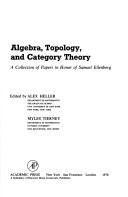
ISBN: 0123390508 1322559147 1483262618 Year: 1976 Publisher: New York : Academic Press,
Abstract | Keywords | Export | Availability | Bookmark
 Loading...
Loading...Choose an application
- Reference Manager
- EndNote
- RefWorks (Direct export to RefWorks)
515.1 --- Algebra --- -Categories (Mathematics) --- -Topology --- -Analysis situs --- Position analysis --- Rubber-sheet geometry --- Geometry --- Polyhedra --- Set theory --- Algebras, Linear --- Category theory (Mathematics) --- Algebra, Homological --- Algebra, Universal --- Group theory --- Logic, Symbolic and mathematical --- Topology --- Functor theory --- Mathematics --- Mathematical analysis --- Addresses, essays, lectures --- Eilenberg, Samuel --- -Bibliography --- Algebra. --- Categories (Mathematics) --- Topology. --- Eilenberg, Samuel, --- Categories (Mathematics). --- 515.1 Topology --- -515.1 Topology --- Analysis situs --- Algèbre --- Catégories (mathématiques) --- Algèbre --- Topologie
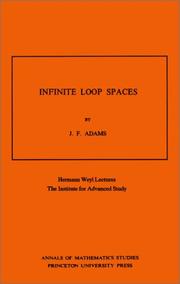
ISBN: 0691082073 0691082065 1400821258 Year: 1978 Volume: no. 90 Publisher: Princeton, N.J.
Abstract | Keywords | Export | Availability | Bookmark
 Loading...
Loading...Choose an application
- Reference Manager
- EndNote
- RefWorks (Direct export to RefWorks)
The theory of infinite loop spaces has been the center of much recent activity in algebraic topology. Frank Adams surveys this extensive work for researchers and students. Among the major topics covered are generalized cohomology theories and spectra; infinite-loop space machines in the sense of Boadman-Vogt, May, and Segal; localization and group completion; the transfer; the Adams conjecture and several proofs of it; and the recent theories of Adams and Priddy and of Madsen, Snaith, and Tornehave.
Algebraic topology --- Loop spaces --- Espaces de lacets --- Infinite loop spaces. --- Abelian group. --- Adams spectral sequence. --- Adjoint functors. --- Algebraic K-theory. --- Algebraic topology. --- Automorphism. --- Axiom. --- Bott periodicity theorem. --- CW complex. --- Calculation. --- Cartesian product. --- Cobordism. --- Coefficient. --- Cofibration. --- Cohomology operation. --- Cohomology ring. --- Cohomology. --- Commutative diagram. --- Continuous function. --- Counterexample. --- De Rham cohomology. --- Diagram (category theory). --- Differentiable manifold. --- Dimension. --- Discrete space. --- Disjoint union. --- Double coset. --- Eilenberg. --- Eilenberg–Steenrod axioms. --- Endomorphism. --- Epimorphism. --- Equivalence class. --- Euler class. --- Existential quantification. --- Explicit formulae (L-function). --- Exterior algebra. --- F-space. --- Fiber bundle. --- Fibration. --- Finite group. --- Function composition. --- Function space. --- Functor. --- Fundamental class. --- Fundamental group. --- Geometry. --- H-space. --- Homology (mathematics). --- Homomorphism. --- Homotopy category. --- Homotopy group. --- Homotopy. --- Hurewicz theorem. --- Inverse limit. --- J-homomorphism. --- K-theory. --- Limit (mathematics). --- Loop space. --- Mathematical induction. --- Maximal torus. --- Module (mathematics). --- Monoid. --- Monoidal category. --- Moore space. --- Morphism. --- Multiplication. --- Natural transformation. --- P-adic number. --- P-complete. --- Parameter space. --- Permutation. --- Prime number. --- Principal bundle. --- Principal ideal domain. --- Pullback (category theory). --- Quotient space (topology). --- Reduced homology. --- Riemannian manifold. --- Ring spectrum. --- Serre spectral sequence. --- Simplicial set. --- Simplicial space. --- Special case. --- Spectral sequence. --- Stable homotopy theory. --- Steenrod algebra. --- Subalgebra. --- Subring. --- Subset. --- Surjective function. --- Theorem. --- Theory. --- Topological K-theory. --- Topological ring. --- Topological space. --- Topology. --- Universal bundle. --- Universal coefficient theorem. --- Vector bundle. --- Weak equivalence (homotopy theory). --- Topologie algébrique
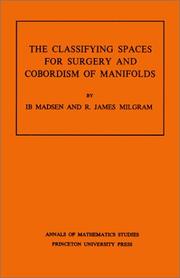
ISBN: 0691082251 069108226X 1400881471 Year: 1979 Publisher: Princeton, N. J.
Abstract | Keywords | Export | Availability | Bookmark
 Loading...
Loading...Choose an application
- Reference Manager
- EndNote
- RefWorks (Direct export to RefWorks)
Beginning with a general discussion of bordism, Professors Madsen and Milgram present the homotopy theory of the surgery classifying spaces and the classifying spaces for the various required bundle theories. The next part covers more recent work on the maps between these spaces and the properties of the PL and Top characteristic classes, and includes integrality theorems for topological and PL manifolds. Later chapters treat the integral cohomology of BPL and Btop. The authors conclude with a discussion of the PL and topological cobordism rings and a construction of the torsion-free generators.
Algebraic topology --- 515.16 --- Classifying spaces --- Cobordism theory --- Manifolds (Mathematics) --- Surgery (Topology) --- Differential topology --- Homotopy equivalences --- Topology --- Geometry, Differential --- Spaces, Classifying --- Fiber bundles (Mathematics) --- Fiber spaces (Mathematics) --- Topology of manifolds --- Classifying spaces. --- Cobordism theory. --- Manifolds (Mathematics). --- Surgery (Topology). --- 515.16 Topology of manifolds --- Bijection. --- Calculation. --- Characteristic class. --- Classification theorem. --- Classifying space. --- Closed manifold. --- Cobordism. --- Coefficient. --- Cohomology. --- Commutative diagram. --- Commutative property. --- Complex projective space. --- Connected sum. --- Corollary. --- Cup product. --- Diagram (category theory). --- Differentiable manifold. --- Disjoint union. --- Disk (mathematics). --- Effective method. --- Eilenberg–Moore spectral sequence. --- Elaboration. --- Equivalence class. --- Exact sequence. --- Exterior algebra. --- Fiber bundle. --- Fibration. --- Function composition. --- H-space. --- Homeomorphism. --- Homomorphism. --- Homotopy fiber. --- Homotopy group. --- Homotopy. --- Hopf algebra. --- Iterative method. --- Loop space. --- Manifold. --- Massey product. --- N-sphere. --- Normal bundle. --- Obstruction theory. --- Pairing. --- Permutation. --- Piecewise linear manifold. --- Piecewise linear. --- Polynomial. --- Prime number. --- Projective space. --- Sequence. --- Simply connected space. --- Special case. --- Spin structure. --- Steenrod algebra. --- Subset. --- Summation. --- Tensor product. --- Theorem. --- Topological group. --- Topological manifold. --- Topology. --- Total order. --- Variétés topologiques --- Topologie differentielle
Book
ISBN: 0691238170 Year: 2005 Publisher: Princeton, New Jersey : Princeton University Press,
Abstract | Keywords | Export | Availability | Bookmark
 Loading...
Loading...Choose an application
- Reference Manager
- EndNote
- RefWorks (Direct export to RefWorks)
It all began atop a drugstore in Princeton, New Jersey, in November 1905. From its modest beginnings, Princeton University Press was to become one of the world's most important scholarly publishers, embracing a wealth of disciplines that have enriched our cultural, academic, and scientific landscape.Both as a tribute to our authors and to celebrate our centenary, Princeton University Press here presents A Century in Books. This beautifully designed volume highlights 100 of the nearly 8,000 books we have published. Necessarily winnowed from a much larger list, these books best typify what has been most lasting, most defining, and most distinctive about our publishing history--from Einstein's The Meaning of Relativity (1922) to the numerous mathematical and other works that marked the Press's watershed decade of the 1940s, including von Neumann and Morgenstern's Theory of Games and Economic Behavior; from milestones of literary criticism by Erich Auerbach and Northop Frye to George Kennan's Pulitzer Prize-winning book on Soviet-American relations; from Milton Friedman and Anna Jacobson Schwartz's A Monetary History of the United States, 1867-1960 to more recent landmarks such as L. Luca Cavalli-Sforza, Paolo Menozzi, and Alberto Piazza's The History and Geography of Human Genes and Robert Shiller's Irrational Exuberance.In addition to succinct descriptions of the 100 titles and a short introduction on the history of the Press, the book features five essays by prominent scholars and writers: Michael Wood discusses the impact on Princeton University Press of intellectuals who fled Nazi Germany and authored many influential books. Anthony Grafton recounts our rich publishing tradition in history, politics, and culture. Sylvia Nasar traces our evolution into a leading voice in economics publishing. Daniel Kevles reflects on Einstein, a figure of special importance to Princeton. And Lord Robert May writes on our long-standing tradition of publishing in mathematics and science.A Century in Books is more than a celebration of 100 years of publishing at Princeton University Press--it is a treasure trove of 100 years of books that have added to the richness of twentieth-century intellectual life.
University presses --- History. --- Princeton University Press --- Ancient history. --- Anthony Grafton. --- Archival research. --- Astronomer. --- Author. --- Book design. --- Book series. --- Burckhardt. --- Capitalism. --- Career. --- Celestial mechanics. --- Clive Granger. --- Computation. --- David Hilbert. --- Econometrics. --- Economist. --- Edith Hamilton. --- Editing. --- Edition (book). --- Editorial. --- Edward Said. --- Empiricism. --- English literature. --- Episode. --- Eranos. --- Ernst Kantorowicz. --- Erudition. --- Erwin Panofsky. --- Essay. --- Facsimile. --- From Caligari to Hitler. --- Gresham Sykes. --- Hans Baron. --- Hardcover. --- Henri Pirenne. --- Hermann Weyl. --- Historicism. --- Humanities. --- Illustration. --- Institution. --- Intellectual history. --- Interwar period. --- J. Franklin Jameson. --- James Merrill. --- John Harsanyi. --- John Maynard Keynes. --- Joseph Strayer. --- Lecture. --- Literature. --- Mainframe computer. --- Mathematician. --- Mathematics. --- Max Planck. --- Modern architecture. --- Modern history. --- Modernity. --- Monarchies in Europe. --- Monograph. --- Narrative. --- Nikolaus Pevsner. --- Novelist. --- Number theory. --- Of Education. --- Old Testament. --- Oskar Morgenstern. --- Paul Samuelson. --- Philology. --- Philosopher. --- Philosophy. --- Physicist. --- Poetry. --- Political science. --- Politics. --- Princeton University Press. --- Princeton University. --- Printing. --- Publication. --- Publishing. --- Renaissance art. --- Renaissance. --- Richard Krautheimer. --- Robert Gilpin. --- Samuel Eilenberg. --- Scientist. --- Stephen Spender. --- Steven Shapin. --- Sylvia Nasar. --- T. S. Eliot. --- Textbook. --- The New York Review of Books. --- The New York Times. --- Theory. --- Time series. --- Time value of money. --- Title page. --- Tradition. --- Vladimir Nabokov. --- Wilhelm Dilthey. --- World War II. --- Writing. --- Auerbach, Erich, 1892-1957 --- Baron, Hans, --- Conkwright, P. J. --- Dilthey, Wilhelm, --- Einstein, Albert, --- Eilenberg, Samuel --- Eliot, T. S. --- Frye, Northrop --- Friedman, Milton, --- Grafton, Anthony --- Granger, C. W. J. --- Gilpin, Robert --- Hilbert, David, --- Hamilton, Edith, --- Harsanyi, John C. --- Jameson, J. Franklin --- Kevles, Daniel J., --- Kennan, George F. --- Kantorowicz, Ernst H. --- Krautheimer, Richard, --- May, Robert M. --- Morgenstern, Oskar, --- Merrill, James, --- Nasar, Sylvia --- Nabokov, Vladimir, --- Panofsky, Erwin, --- Pirenne, Henri, --- Planck, Max, --- Pevsner, Nikolaus, --- Schwartz, Anna J. --- Said, Edward W. --- Sykes, Gresham M. --- Strayer, Joseph R. --- Samuelson, Paul A. --- Spender, Stephen, --- Shapin, Steven --- Von Neumann, John, --- Wood, Michael, --- Wright, Frank Lloyd, --- Weyl, Hermann,
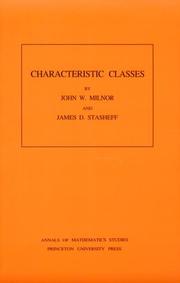
ISBN: 0691081220 9780691081229 140088182X Year: 1974 Volume: 76 Publisher: Princeton, N.J. Princeton University Press
Abstract | Keywords | Export | Availability | Bookmark
 Loading...
Loading...Choose an application
- Reference Manager
- EndNote
- RefWorks (Direct export to RefWorks)
The theory of characteristic classes provides a meeting ground for the various disciplines of differential topology, differential and algebraic geometry, cohomology, and fiber bundle theory. As such, it is a fundamental and an essential tool in the study of differentiable manifolds.In this volume, the authors provide a thorough introduction to characteristic classes, with detailed studies of Stiefel-Whitney classes, Chern classes, Pontrjagin classes, and the Euler class. Three appendices cover the basics of cohomology theory and the differential forms approach to characteristic classes, and provide an account of Bernoulli numbers.Based on lecture notes of John Milnor, which first appeared at Princeton University in 1957 and have been widely studied by graduate students of topology ever since, this published version has been completely revised and corrected.
Algebraic topology --- Characteristic classes --- Classes caractéristiques --- 515.16 --- #WWIS:d.d. Prof. L. Bouckaert/ALTO --- Classes, Characteristic --- Differential topology --- Topology of manifolds --- Characteristic classes. --- 515.16 Topology of manifolds --- Classes caractéristiques --- Additive group. --- Axiom. --- Basis (linear algebra). --- Boundary (topology). --- Bundle map. --- CW complex. --- Canonical map. --- Cap product. --- Cartesian product. --- Characteristic class. --- Charles Ehresmann. --- Chern class. --- Classifying space. --- Coefficient. --- Cohomology ring. --- Cohomology. --- Compact space. --- Complex dimension. --- Complex manifold. --- Complex vector bundle. --- Complexification. --- Computation. --- Conformal geometry. --- Continuous function. --- Coordinate space. --- Cross product. --- De Rham cohomology. --- Diffeomorphism. --- Differentiable manifold. --- Differential form. --- Differential operator. --- Dimension (vector space). --- Dimension. --- Direct sum. --- Directional derivative. --- Eilenberg–Steenrod axioms. --- Embedding. --- Equivalence class. --- Euler class. --- Euler number. --- Existence theorem. --- Existential quantification. --- Exterior (topology). --- Fiber bundle. --- Fundamental class. --- Fundamental group. --- General linear group. --- Grassmannian. --- Gysin sequence. --- Hausdorff space. --- Homeomorphism. --- Homology (mathematics). --- Homotopy. --- Identity element. --- Integer. --- Interior (topology). --- Isomorphism class. --- J-homomorphism. --- K-theory. --- Leibniz integral rule. --- Levi-Civita connection. --- Limit of a sequence. --- Linear map. --- Metric space. --- Natural number. --- Natural topology. --- Neighbourhood (mathematics). --- Normal bundle. --- Open set. --- Orthogonal complement. --- Orthogonal group. --- Orthonormal basis. --- Partition of unity. --- Permutation. --- Polynomial. --- Power series. --- Principal ideal domain. --- Projection (mathematics). --- Representation ring. --- Riemannian manifold. --- Sequence. --- Singular homology. --- Smoothness. --- Special case. --- Steenrod algebra. --- Stiefel–Whitney class. --- Subgroup. --- Subset. --- Symmetric function. --- Tangent bundle. --- Tensor product. --- Theorem. --- Thom space. --- Topological space. --- Topology. --- Unit disk. --- Unit vector. --- Variable (mathematics). --- Vector bundle. --- Vector space. --- Topologie differentielle --- Classes caracteristiques --- Classes et nombres caracteristiques
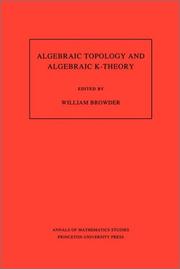
ISBN: 0691084157 0691084262 1400882117 Year: 1987 Publisher: Princeton (N.J.): Princeton university press
Abstract | Keywords | Export | Availability | Bookmark
 Loading...
Loading...Choose an application
- Reference Manager
- EndNote
- RefWorks (Direct export to RefWorks)
This book contains accounts of talks held at a symposium in honorof John C. Moore in October 1983 at Princeton University, The workincludes papers in classical homotopy theory, homological algebra,rational homotopy theory, algebraic K-theory of spaces, and othersubjects.
Algebraic topology --- K-theory --- 512.73 --- 515.14 --- 512.73 Cohomology theory of algebraic varieties and schemes --- Cohomology theory of algebraic varieties and schemes --- 515.14 Algebraic topology --- Moore, John C. --- Abelian group. --- Adams spectral sequence. --- Adjoint functors. --- Adjunction (field theory). --- Algebraic K-theory. --- Algebraic closure. --- Algebraic geometry. --- Algebraic group. --- Algebraic number field. --- Algebraic space. --- Algebraic topology. --- Algebraically closed field. --- Associative algebra. --- Boundary (topology). --- CW complex. --- Classification theorem. --- Closure (mathematics). --- Coalgebra. --- Cofibration. --- Cohomology. --- Commutative diagram. --- Commutative property. --- Coproduct. --- Deformation theory. --- Degenerate bilinear form. --- Diagram (category theory). --- Differentiable manifold. --- Dimension (vector space). --- Division algebra. --- Eilenberg–Moore spectral sequence. --- Epimorphism. --- Exterior (topology). --- Formal power series. --- Free Lie algebra. --- Free algebra. --- Freudenthal suspension theorem. --- Function (mathematics). --- Function space. --- Functor. --- G-module. --- Galois extension. --- Global dimension. --- Group cohomology. --- Group homomorphism. --- H-space. --- Hilbert's Theorem 90. --- Homology (mathematics). --- Homomorphism. --- Homotopy category. --- Homotopy group. --- Homotopy. --- Hopf algebra. --- Hopf invariant. --- Hurewicz theorem. --- Inclusion map. --- Inequality (mathematics). --- Integral domain. --- Isometry. --- Isomorphism class. --- K-theory. --- Lie algebra. --- Lie group. --- Limit (category theory). --- Loop space. --- Mathematician. --- Mathematics. --- Noetherian ring. --- Order topology. --- P-adic number. --- Polynomial ring. --- Polynomial. --- Prime number. --- Principal bundle. --- Principal ideal domain. --- Projective module. --- Projective plane. --- Pullback (category theory). --- Pushout (category theory). --- Ring of integers. --- Series (mathematics). --- Sheaf (mathematics). --- Simplicial category. --- Simplicial complex. --- Simplicial set. --- Special case. --- Spectral sequence. --- Square (algebra). --- Stable homotopy theory. --- Steenrod algebra. --- Superalgebra. --- Theorem. --- Topological K-theory. --- Topological space. --- Topology. --- Triviality (mathematics). --- Uniqueness theorem. --- Universal enveloping algebra. --- Vector bundle. --- Weak equivalence (homotopy theory). --- William Browder (mathematician). --- Géométrie algébrique --- K-théorie
Book
ISBN: 0691653682 1400875668 9781400875665 9780691079479 9780691627748 0691627746 9780691627748 Year: 2015 Publisher: Princeton, NJ
Abstract | Keywords | Export | Availability | Bookmark
 Loading...
Loading...Choose an application
- Reference Manager
- EndNote
- RefWorks (Direct export to RefWorks)
Book 4 in the Princeton Mathematical Series.Originally published in 1941.The Princeton Legacy Library uses the latest print-on-demand technology to again make available previously out-of-print books from the distinguished backlist of Princeton University Press. These editions preserve the original texts of these important books while presenting them in durable paperback and hardcover editions. The goal of the Princeton Legacy Library is to vastly increase access to the rich scholarly heritage found in the thousands of books published by Princeton University Press since its founding in 1905.
Topology. --- Analysis situs --- Position analysis --- Rubber-sheet geometry --- Geometry --- Polyhedra --- Set theory --- Algebras, Linear --- Abelian group. --- Additive group. --- Adjunction (field theory). --- Algebraic connectivity. --- Algebraic number. --- Annihilator (ring theory). --- Automorphism. --- Barycentric coordinate system. --- Barycentric subdivision. --- Big O notation. --- Boundary (topology). --- Cantor set. --- Cardinal number. --- Cartesian coordinate system. --- Cauchy sequence. --- Character group. --- Circumference. --- Cohomology. --- Combinatorics. --- Compact space. --- Complete metric space. --- Complex number. --- Computation. --- Continuous function (set theory). --- Continuous function. --- Contractible space. --- Cyclic group. --- Dense set. --- Diameter. --- Dimension (vector space). --- Dimension function. --- Dimension theory (algebra). --- Dimension. --- Dimensional analysis. --- Discrete group. --- Disjoint sets. --- Domain of a function. --- Equation. --- Euclidean space. --- Existential quantification. --- Exponentiation. --- Function (mathematics). --- Function space. --- Fundamental theorem. --- Geometry. --- Group theory. --- Hausdorff dimension. --- Hausdorff space. --- Hilbert cube. --- Hilbert space. --- Homeomorphism. --- Homology (mathematics). --- Homomorphism. --- Homotopy. --- Hyperplane. --- Integer. --- Interior (topology). --- Invariance of domain. --- Inverse system. --- Linear space (geometry). --- Linear subspace. --- Lp space. --- Mathematical induction. --- Mathematics. --- Metric space. --- Multiplicative group. --- N-sphere. --- Natural number. --- Natural transformation. --- Ordinal number. --- Orientability. --- Parity (mathematics). --- Partial function. --- Partially ordered set. --- Point (geometry). --- Polytope. --- Projection (linear algebra). --- Samuel Eilenberg. --- Separable space. --- Separated sets. --- Set (mathematics). --- Set theory. --- Sign (mathematics). --- Simplex. --- Special case. --- Subgroup. --- Subsequence. --- Subset. --- Summation. --- Theorem. --- Three-dimensional space (mathematics). --- Topological group. --- Topological property. --- Topological space. --- Transfinite. --- Transitive relation. --- Unit sphere. --- Upper and lower bounds. --- Variable (mathematics).
| Listing 1 - 9 of 9 |
Sort by
|

 Search
Search Feedback
Feedback About UniCat
About UniCat  Help
Help News
News